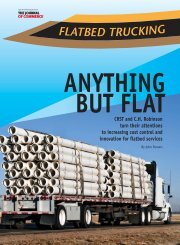Options to Weigh When Choosing a TMS Solution - CH Robinson
Options to Weigh When Choosing a TMS Solution - CH Robinson
Options to Weigh When Choosing a TMS Solution - CH Robinson
Create successful ePaper yourself
Turn your PDF publications into a flip-book with our unique Google optimized e-Paper software.
Retuning Demand Forecast Muddled by Recession (continued)<br />
retaining the logistics department’s staff . Many companies<br />
have limited career paths for transportation professionals,<br />
and it is not uncommon for logistics employees with soft -<br />
ware training <strong>to</strong> take jobs at other companies <strong>to</strong> further their<br />
careers. <strong>When</strong> licensing a <strong>TMS</strong>, the company will generally<br />
also have <strong>to</strong> pay continual ongoing maintenance and support<br />
fees related <strong>to</strong> the <strong>TMS</strong>, which can vary annually from 18<br />
percent <strong>to</strong> 25 percent of the <strong>to</strong>tal license costs.<br />
Scenario 2: High Turnover<br />
Aft er determining that managing a <strong>TMS</strong> internally is<br />
beyond its scope, Company B decides <strong>to</strong> use a soft ware vendor<br />
<strong>to</strong> host its <strong>TMS</strong>. Initially, this decision works out well,<br />
but over time, the company’s trained staff leave <strong>to</strong> pursue<br />
opportunities with larger companies that off er higher pay<br />
for their expertise. Company B ends up incurring additional,<br />
unexpected training and recruiting costs that eat away at<br />
its long-term savings, and, more importantly, uses its <strong>TMS</strong><br />
sub-optimally.<br />
Before deciding <strong>to</strong> have a soft ware provider host your<br />
<strong>TMS</strong>, consider how you will retain your trained staff and<br />
avoid the turnover that will lead <strong>to</strong> a loss of valuable employees<br />
and an increase in recruiting and training costs. If a company<br />
is unable <strong>to</strong> retain trained staff , it may experience the<br />
<strong>TMS</strong> PROS AND CONS<br />
<strong>TMS</strong> Option<br />
License the <strong>TMS</strong><br />
and manage internally<br />
License and host the <strong>TMS</strong> with a<br />
software provider<br />
same type of imbalance between costs and savings as if it had<br />
managed the <strong>TMS</strong> internally.<br />
<strong>Choosing</strong> <strong>to</strong> Outsource <strong>to</strong> a 3PL<br />
Since there are many outsourced <strong>TMS</strong> models available,<br />
companies should fully investigate all options that prospective<br />
3PLs off er and choose the one that best aligns with their<br />
business. Th e most popular 3PL solutions are (1) the single<br />
source and (2) the lead logistics (4PL) model. Since there is<br />
more than one model, your fi rst consideration is <strong>to</strong> determine<br />
which one is right for your business.<br />
For companies with smaller transportation spends<br />
or less head count, a single source may off er the greatest<br />
potential value. Th e single-source solution combines all the<br />
benefi ts of the <strong>TMS</strong> and established carrier relationships.<br />
Th is model can solve capacity challenges. Th e 3PLs are also<br />
likely <strong>to</strong> provide the cus<strong>to</strong>mer with lower freight rates due<br />
<strong>to</strong> their broad access <strong>to</strong> capacity and purchasing power. An<br />
additional benefi t is that the cus<strong>to</strong>mer negotiates all the rates<br />
with one 3PL provider rather than with many carriers.<br />
It is important <strong>to</strong> consider a complicating fac<strong>to</strong>r in the<br />
single-source model: 3PLs make a margin on the diff erence<br />
between what they charge <strong>to</strong> their cus<strong>to</strong>mer and their cost<br />
Pros Cons<br />
● Use own IT staff <strong>to</strong> implement and ● High up-front costs<br />
maintain the software<br />
● Longer, more complex, and<br />
● Low ongoing licensing fees<br />
expensive implementation<br />
● Requires trained staff <strong>to</strong> learn,<br />
manage, operate, and maintain the<br />
software<br />
● Mid- <strong>to</strong> long-term software<br />
maintenance costs<br />
● Ongoing IT dependency<br />
● Low up-front costs<br />
● Minimal IT dependency<br />
● Short implementation<br />
Outsource <strong>to</strong> a 3PL ● Low up-front costs<br />
● Minimal IT dependency<br />
● Short implementation<br />
● Includes professional <strong>TMS</strong><br />
operations staff<br />
● Ongoing leasing costs<br />
● Requires trained staff <strong>to</strong> learn,<br />
manage, and operate the software<br />
● Need <strong>to</strong> interface existing order<br />
system with the <strong>TMS</strong><br />
● Ongoing outsource costs<br />
● Need <strong>to</strong> interface existing order<br />
system with the <strong>TMS</strong><br />
2 | supply chain strategy www.ioma.com/supply_chain




